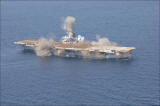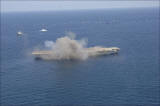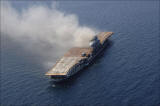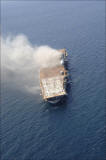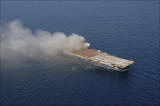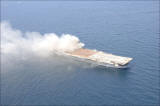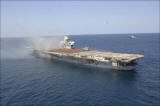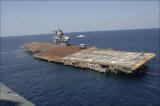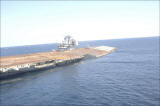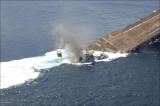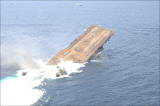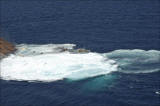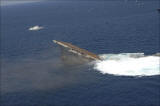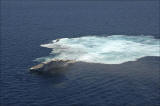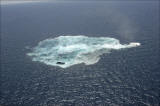(Here's what I look like now (2006). I have some older pictures I will have to
scan in.) 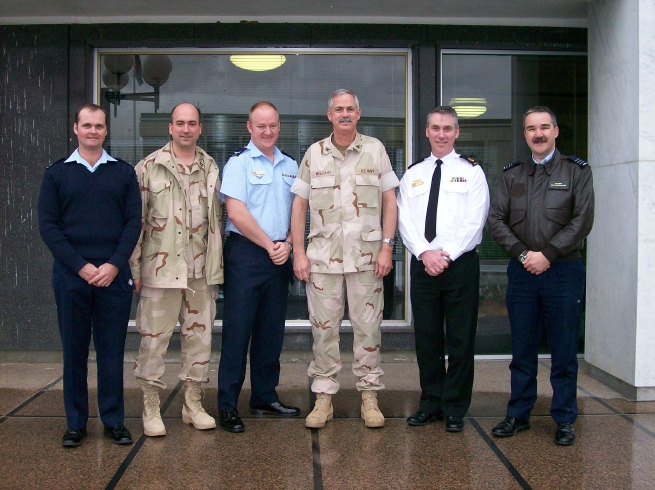
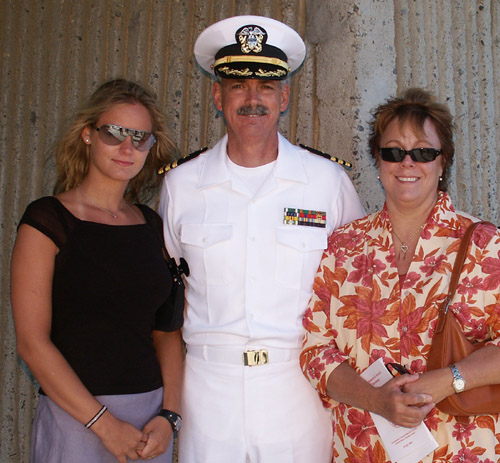
From L-R, daughter Elisabeth, me, wife Vicki (married 35 years), missing son Jon.
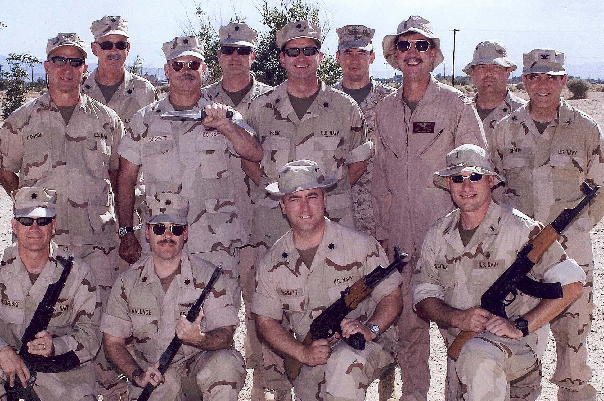
Me and the boys! (I'm the old guy, last row on the left)
New: Sinking Photos and Articles!
I was going to Eglin AFB to attend a seminar on recent enemy threat weapons being used against U.S. aircraft. I had read for some months on the web that the Oriskany would be sunk to her final resting place, 220 feet down, as an artificial reef. So, I figured I'd go to Florida a day early and visit my first aircraft carrier, the Oriskany, CV/CVA-34.
Monday morning, I put on my uniform and drove up to NAS Pensacola where the Oriskany is berthed. I wore it because I was pretty sure that no one would stop me from getting close to the ship while in uniform vs. wearing civilian clothes. I was right! There was a guard shack at the entrance to the pier. When the Marine sentry saw the silver oak leaves, he saluted and waived me through. No problem. (Note: As a LT, I took a fair amount of gaffe; as a LCDR, much less so; Nobody screws with a full commander.)
I got out of the rental car with my cheap digital camera and proceeded to take some photos. The old girl had seen better days. Rusted, paint flaking, most of the mast radars gone, a shell of her former self.
As I moved around the pier, I saw that there were no military - only civilian workers getting the Mighty O ready for sinking. As I lined up shots, an electrician working on a pier side junction box saw me and started talking.
"She's going to be sunk, you know?"
"Yeah, I heard. Too bad."
"Were you ever aboard?"
I mentioned that I was a crewmember, part of the airwing, some years ago (some long years ago - 1972-1974 - thirty-two years since I had last been aboard.) We talked some more.
"Hey," he said, "I'll bet you could go aboard." My head turned and my eyes lit up
"You think so?" I asked.
"Sure. You're in the Navy. I'll bet you can just go on board." Then he reached down into his truck bed.
"Here, here's my hard hat."
Before he could say "hat," I took it, removed my cover, and put it on.
An old chief I had many years ago told me some valuable advice I have always tried to honor: "If you are going to be someplace that maybe you shouldn't be, or aren't sure if you should, don't sneak around, hiding from view and keeping quiet. Instead, turn on all the lights, open all the doors, turn the music up full blast, and pretend like you're supposed to be there."
I walked up the afterbrow like I owned the place. I was Capt. Barrow or Capt Anderson, walking onboard to see my ship. No one said a word except "Hi."
I took my first step aboard the ship in all those years. Everything changed. There I was, 20 years old again. I was an Aviation Electronics Technician Airman (ATAN), assigned to VA-155, the Silver Foxes, flying the A-7B. Ricky Hamilton (who was a funny guy and could make anybody laugh), also an ATAN, who I had met in A School at NAS Memphis and another Southern Californian (there are some of us who are normal), and I were reporting aboard our first ship for our first cruise, a long way from home. I looked at the ship through those eyes, remembered the smells of Subic Bay, and walked on board.
Things had changed. The ship, mothballed in 1976, had no work done to it. Rust was everywhere. The civilian contractors had been readying the ship for sinking. Hatches had been cut open or welded shut. In various places on the hanger bay, 6x6 foot holes had been cut through the deckplates to allow for flooding. I started to take pictures.
As I walked around, I began to realize I might be the last crewmember to go aboard before the sinking. And, I felt very nostalgic. I was seeing the same sights I had seen for two cruises, but with a few changes. As I took more pictures, one of the civilian contractors came up to me. He was the lead man for the workers and was afraid I was there because of an OSHA complaint made by one of the subcontractors on the job. I assured him I had nothing to do with it, and he gave me a tour.
He explained that the ship was being readied from the mast to the sea chest (top to bottom) for the sinking. All of the hazardous materials were being removed. Asbestos from all the spaces and the overhead in the hanger bay (I didn't know I was working near that stuff - who did?) had to be stripped out. All of the fuel tanks and fuel lines throughout the ship (519 of them) had to be purged and cleaned. Everything from the top of the mast to the flight deck was being made diver safe so scuba divers could visit without being trapped. All hatches and doors, windows and glass, and trap hazards like the catapult rails were being removed or sealed so a diver couldn't get caught while visiting. So the mast, island, and flight deck were safe. But below that, there were no precautions. From what I could see, you could very easily get caught below decks. No lights, passageways that form a maze, hatches blocking exits. I remember many times ending up in some part of the ship and wondering "How did I get here, and how do I get back?," in a lighted compartment and plenty of air to breath.
Did I want to see the flight deck? Yes, please. We walked up the old escalator to the island. I told him modern carriers don't have escalators. In fact, Oriskany was the only carrier I have been on that had one.
All the non-skid was gone. The pad-eyes that were formerly at deck level were four inches above the deckplate. (And to think I was blowing out one of those things when we crossed the equator in December of 1973 and become Loyal Shellback vs. a slimy pollywog.)
I found out the ship is going to be sunk by the Army! Army EOD experts are going to place charges at the induction pipes in the sea chest (this is where the ship draws in salt water for various uses like drinking water after distillation and flush water for the heads). Water will fill the ship slowly, entering all the major compartments. The ship will take five hours to sink, plus or minus fifteen minutes. (I asked how they could be so accurate - "After a hundred ship sinkings, we have a model that predicts the rate of filling. We are almost never wrong." It will be monitored electronically as it floods.
We went back down to the hanger bay and it was time to go. They were busy and I had friends to visit at Naval Aviation Schools Command where I had once taught. But before I left, I had a request. A couple of mementos. The lead man had a couple of his workers remove some placards that were going to sink with the ship, and I took some of the rusted hanger bay deckplate back with me.

So many fond memories. Working alongside Rick trying to fix those airplane's avionics systems (never got the last gripe fixed it seemed), hosting a radio show on KRIS Saturdays and Sundays (folk rock music mostly), making friends with other electronic types like George Thomann (a huge man and one of the most powerful bowlers I have ever seen) and Jeff Webster from the OE division (ETs from ship's company, also radio show hosts), visiting the Philippines, Hong Kong, Japan, working on the flight deck (number three on the Discovery Channel's 10 most dangerous places), etc.
It's a sad time, but a good time as well. The Oriskany will always be in one spot, viewable to those that can scuba dive. At least you will never wonder if the next can of dog food you open is made from a part of the old ship.
If you have any comments, or just want to write and say hi, please contact me at mailto:patrick_mulcahy@yahoo.com .
All the best,
Pat (April, 2006)
Some pictures from my last visit, and some from my first visit (as soon as I can find a cheap slide scanner.) Both of these sets of pictures have never been seen before. In fact, I found the slides from the 1973 cruise recently after some 30 years of hiding somewhere in my garage.
Go down to see more photos:










